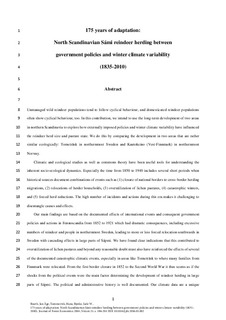| dc.contributor.author | Riseth, Jan Åge | |
| dc.contributor.author | Tømmervik, Hans | |
| dc.contributor.author | Bjerke, Jarle W. | |
| dc.date.accessioned | 2020-02-07T11:03:20Z | |
| dc.date.available | 2020-02-07T11:03:20Z | |
| dc.date.created | 2016-08-17T13:24:59Z | |
| dc.date.issued | 2016 | |
| dc.identifier.citation | Journal of Forest Economics. 2016, 24 186-204. | |
| dc.identifier.issn | 1104-6899 | |
| dc.identifier.uri | http://hdl.handle.net/11250/2640353 | |
| dc.description.abstract | Unmanaged wild reindeer populations tend to follow cyclical behaviour, and domesticatedreindeer populations often show cyclical behaviour, too. In this contribution, we intendto use the long-term development of two areas in northern Scandinavia to explore howexternally imposed policies and winter climate variability have influenced the reindeer herdsize and pasture state. We do this by comparing the development in two areas that are rathersimilar ecologically: Torneträsk in northernmost Sweden and Kautokeino (Vest-Finnmark)in northernmost Norway.Climatic and ecological studies as well as commons theory have been useful tools forunderstanding the inherent socio-ecological dynamics. Especially the time from 1850 to1940 includes several short periods when historical sources document combinations ofevents such as (1) closure of national borders to cross-border herding migrations, (2) relo-cations of herder households, (3) overutilization of lichen pastures, (4) catastrophic winters,and (5) forced herd reductions. The high number of incidents and actions during this eramakes it challenging to disentangle causes and effects.Our main findings are based on the documented effects of international events and con-sequent government policies and actions in Fennoscandia from 1852 to 1921 which haddramatic consequences, including excessive numbers of reindeer and people in north-ernmost Sweden, leading to more or less forced relocation southwards in Sweden withcascading effects in large parts of Sápmi. We have found clear indications that this con-tributed to overutilization of lichen pastures and beyond any reasonable doubt must alsohave reinforced the effects of several of the documented catastrophic climatic events, espe-cially in areas like Torneträsk to where many families from Finnmark were relocated. Fromthe first border closure in 1852 to the Second World War it thus seems as if the shocks fromthe political events were the main factor determining the development of reindeer herdingin large parts of Sápmi. The political and administrative history is well documented. Ourclimate data are a unique compilation of climate events based on multiple sources duringtwo centuries, which contribute to the validity of our findings. Our pasture state data fromthe late-1800s are also based on several sources which support each other. Reindeer herding, Adaptation, Political shocks, Climate events, Pasture state | |
| dc.language.iso | eng | |
| dc.title | 175 years of adaptation: North Scandinavian Sámi reindeer herding between government policies and winter climate variability (1835–2010) | |
| dc.type | Peer reviewed | |
| dc.type | Journal article | |
| dc.description.version | acceptedVersion | |
| cristin.unitcode | 6002,2,0,0 | |
| cristin.unitname | Norut Northern Research Institue AS, Samfunn | |
| cristin.ispublished | true | |
| cristin.fulltext | postprint | |
| cristin.qualitycode | 1 | |
| dc.identifier.doi | 10.1016/j.jfe.2016.05.002 | |
| dc.identifier.cristin | 1373485 | |
| dc.source.journal | Journal of Forest Economics | |
| dc.source.volume | 24 | |
| dc.source.pagenumber | 186-204 | |
| dc.relation.project | Nordisk ministerråd: Nordic Centre of Excellence (NCoE) project CLINF | |
| dc.relation.project | Andre: FRAM – High North Research Centre for Climate and the | |
| dc.relation.project | Norges forskningsråd: 225006 | |
| dc.relation.project | Norges forskningsråd: 216434 | |
